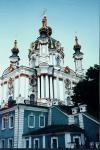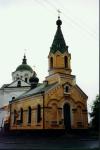FRIDAY JULY 25

Today is set aside to visit the Podil district. We take the subway to Poshtova Ploshcha and then ride the 1905 funicular up the steep wooded slope to the top of Vladimir Hill. The trip costs pennies at thirty kopijok each. We zig when we should have zagged at the imposing Ministry of Foreign Affairs building and find ourselves staring at the St. Sophia complex. We backtrack past a few blocks of park containing a few odd statues and some interesting benches. Across the street from the park at Mikhailivska (ST Michael's) Ploshcha is a monument with sculptures of Princess Olya, and missionaries Cyril and Methodius. We again pass the monolithic former communist party headquarters, this time heading in the right direction. A good walk down Desyatinna Vulytsya leads us to the majestic St. Andrews Church. Sadly the church is closed for renovation, but the elegant exterior is worth the visit. Appropriately it is situated on the highest hill of old Kyiv. Shades of blue accented by white columns dominate the exterior color. The church, crowned with green domes and adorned with sparkling gold is without doubt a feast for the eyes. Maneuvering past souvenir sellers, we ascend a few steps to the site of the former Desyatinna Tservka. This was the first church built by Prince Vladimir based on Byzantium influence. Red quartz now outlines it's foundation, so one has to use your imagination to visualize it's greatness. Still on these grounds we come upon the Ukraine History museum, but we just look at stuff displayed outside and enjoy the view from the terrace.
We descend the curving cobblestone hill of Andryivski Uzviz. Both sides of the street are lined with vendors selling Ukrainian junk and t-shirts. Further along, artists of different dimensions display their work. Mass production and increased cost is noticeable since I was last here. We walk right past the Castle of Richard the Lion-Hearted as it looks like a hotel. We rest at the Mikhail Bulgakov House. At the bottom of the hill, we turn right onto Borochiv Tic and enter the Pokrovska Church complex. The church is large and boasts an equally large bell tower. It is closed for renovations so we cross Vulitsya Pokrovska to the little Chapel Church of Mykola Dobry - also closed. Farther down the street is the residence of the American Ambassador (more renovating). A walk around the block brings us to the vicinity of Kontraktova Ploshcha. There are some fountains, but generally the square is dull and not very clean. I made a note that a photo had been taken of the Samsonite Fountain, but I appear to have a poltergeist in my camera as many photos I took mysteriously have not been retained on film. Anyway, this fountain is kinda fun as it has Sampson wresting a less than ferocious lion. At the far end of the square is a large statue of the philosopher Skovoroda. Continuing on our quest for more sights, we wander past the prestigious former Kyivian Mohyla Academy established by Peter the Great and later shut down by Tsar Nicholas. We walk down Vulitsya Illinska in the direction of the river.
A wedding is in progress when we get to the white stone Illinska Tservka (church) so we walk half a block to the small Naberezno Mykilska Church. Here a marriage ceremony is also taking place, so we stay near the door and watch the proceedings from the perimeter. Crowns are held above the bride's and groom's head while the priest presides over the nuptials. Following the prayers, the newlyweds are paraded around the church a number of times. Melodious bells toll, signally the completion the ceremony. We return to the Illinska Church but another wedding party is waiting for their turn to enter. I leave Bill in the park across the street and walk back to look around the grounds at the little church we just exited. A fairly large whitewashed church is built onto the little church, but unfortunately it is locked. I go back into the little attached church which is actually the bell tower that incorporates the small church to see the start of another wedding. I join Bill as we wait for an opportunity to view the inside of the Illinska Church, but it soon becomes apparent that there will be no breaks in wedding ceremonies being performed. As each ceremony is almost finished, many cars and busloads of people come roaring up at dangerous speed. The wedding party and guest empty onto the street to wait for their turn. Those who have just been united emerge from the church and zoom off to who knows where and those betrothed immediately enter to sanctify their marriage. We saw this over and over again at other churches, so the weddings must be booked bang - bang - one after another and no dawdling is allowed. Judging from the number of weddings held today, it appears that Friday is marriage day. I wander through the milling guests and peek inside the church. There are few people in the church and I respectfully leave when a female gives me a rather anxious look. Instead I snoop around the well kept grounds and buildings. I can hear running water and despite a chair blocking the entrance to the building, I investigate and find what appears to be a baptism tub, large enough to hold an adult. Another wedding party has arrived and rather than upset yet another family with my uninvited presence, I collect Bill and we trek on.
Surrounded by an iron gate is a small white house. Curious I enter the grounds and enquire of a woman having a smoke break what place this is. It is a museum dedicated to Cossack Chieftains and in particular to Mazepa, the last of these great military leaders. During the early 1700's he had a plan to secede from Russia. It failed when the guys buried at the Lavra ratted on him. A gamut of wood carvings and paintings are displayed in a good size room. The bulk of the collection is by a local artist who has spent his lifetime creating these magnificent pieces. From his body of work we are easily able to determine the lifestyles and dress of these hetman. It appears they were hard drinkers and had a penchant for fast horses. A young woman offers to accompany us upstairs to a photo gallery, but it not interesting as I know nothing of the folks in the pictures. Back downstairs, the smoking lady spends considerable time explaining the history of that time and allows us to handle swords and daggers that is part of the collection. The museum is not complete but the women are eager to show us what little there is on display. It is being put together by a few dedicated volunteers. We meet another one of these women on our way out, who cannot thank us enough for coming, so I gather they do not get very many visitors.
The Chernobyl Museum is closed for renovations, so we find a neat little restaurant and enjoy cheese and potato vereniky. We laugh at the frugal nature of Ukrainians as already small paper napkins are cut in half. A grocery store across the street sports a sign reading "fresh food". Our next stop is at Peter The Great's Headquarters. We climb the stairs to the porch and can see that the inside is used to store stuff. I would have expected the house to be opulent, but from the outside it is rather plain. We carry on to the Catholic Church of Mykola Prytysko, the oldest church in Podil. The entrance to the church has dark granite floors. Walls are a dark green with earth tone decoration which gives a stunning effect. There are remnants of ancient frescoes in similar colour. Inside, the church is beige bright. The iconostasis is rather plain, but there are remnants of old frescoes and a few nice icons. A wedding is underway under a canopy of scaffolding and wooden platforms. From the time I enter, a guest has been rattling cellophane and butcher paper as she wraps and re-wraps her wedding gift. This noise makes it difficult to hear the ceremony. Other guests frequently look disapprovingly at her and finally one approaches her and she stops the racket. Between her and the dog fights outside, I would love to hear what the video of the wedding sounded like.
Our last excursion takes us to what may be Vosnesenka Church - part of the Florivsky Monastery. Unfortunately, my notes are lousy and the camera poltergeist is again at work. If I recall correctly, the interior is really blue. The ceiling is painted with religious images with words printed below, possibly explaining the story. I saw no embroidery. Instead lace curtains are draped around the pictures and icons. There are a few nuns about, one which is hassling a char woman regarding the cleanliness of the floor. In the complex are many elderly nuns going about their chores, so we feel we should not intrude and therefore do not explore the rest of the convent. A well near the cathedral had a few folks lined up to get water that is believed to be medicinal and retain youth.
Somehow we wound our way back to the river from here. It is a pleasant evening so the stroll to Ploshcha Postova is leisurely. Nearby is a monument to the sailors of the military flotilla that gave their lives for freedom. We take the metro to the train station and walk to the Lybed Hotel to exchange money. No longer poverty stricken we eat at the restaurant we visited on our arrival. Tonight the food is not very good. Back to the train station we encounter considerable difficulty in finding the entrance to the metro. Instead of being in a panic, we take the opportunity to examine the products numerous vendors are selling. Eventually the entrance is found and we are on our way home.
Over tea and cookies, we chat with Olya. Communism was responsible for the "great famine" of 1932-1933. Stalin deliberately starved to death ten million people and the peasants were the primary victims. Some say the famine was orchestrated in order to stop the threat of Nationalism that many peasants embraced. Olya shares that Stalin wanted collective farming, so wealthy land-owners were sent to Siberia and their land confiscated. She agreed that food was sent to the USSR, but felt the major problem lay in the fact that because the hardworking land owners were killed or shipped off, this left only the lazy and the drunks to produce the food. These folks did not produce enough food to feed the villages and so those folks soon left for the cities in search of a better life. Unfortunately hunger prevailed. Olya said it was awful, as people had swollen bellies and the dying were everywhere on the streets of Kyiv.

All materials herein are copyrighted by the author. Permission must be granted by the author for any use of the material (text or images) contained in this diary. E-mail: theclarks@telus.net.
